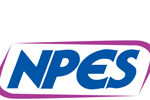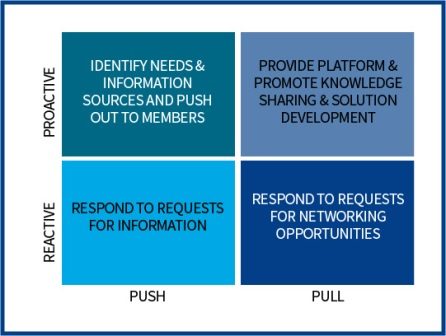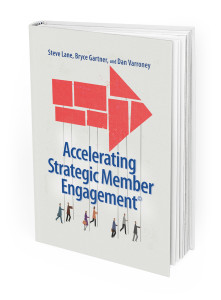Polarization in Washington, DC, and market disruption are opening doors for Associations to create more compelling member engagement experiences for their members. Associations can be more proactive and less reactive by providing more opportunities for their members to share knowledge and build new solutions that drive business and professional outcomes.
Compelling Member Engagement Using “Pull” and “Push”
The customary approach for associations is to seek out knowledge experts and then “push” that person’s knowledge out to the masses via educational programs, newsletters, and journals. Today’s associations who view their role as the integrator, aggregator, curator and enabler are creating more compelling member engagement experiences. This is accomplished by “pulling” members together and facilitating the sharing of knowledge so that innovative solutions are created to address shared challenges and opportunities. The “push” and “pull” doctrine means that your association:
- Captures the insights of many members and stakeholders.
- Provides the tools that enable members to tap into the collective knowledge of the critical insights as soon as they need them.
Surface Critical Challenges That Must Be Addressed
Your organizations can utilize focus groups and survey research to pinpoint industry and professional challenges that must be addressed. This means utilizing survey instruments that identify member “up at night” issues and then engaging your board and key volunteer leaders to understand the full impact of what is learned and how it can be applied successfully to impact professions and drive business outcomes. Having research based conclusions is an essential part of creating a more compelling member engagement.
Identify Who Most Wants to Contribute and Collaborate
Being able to pinpoint those members who want to most contribute and collaborate will help your association build the more compelling member engagement experiences. In the strategic member engagement survey released in 2014, those associations and professional societies who report that they can identify member segments that want to contribute and collaborate more often:
- Have a board that understands and strategizes about core member needs to a “very high” degree.
- Report an upward trend in 3-year annual revenue.
Applying the Pull and Push Doctrine at Your Association
Since association boards and CEO’s want their organization to be more pro-active and less reactive, the push and pull doctrine is increasingly important. What’s more important is how your association transforms from a reactive to a proactive posture in relatively short period of time. Utilizing this box, you can reposition products or services to become more timely and impactful to member’s professional challenges and business growth outcomes.
Case Study – Creating More Compelling Member Engagement
 The American Association for Marriage and Family Therapy based in Alexandria, Virginia has 25,000 members that fall into three core groups: Academics, Agency, and Private Practice. The Profession utilizes the organization as its platform to advance the Profession and practice of marriage and family therapy. According to Tracy Todd, Chief Executive Officer of AAMFT, the starting point for critical therapy topics (“push”) for their members include that the Association and its online community:
The American Association for Marriage and Family Therapy based in Alexandria, Virginia has 25,000 members that fall into three core groups: Academics, Agency, and Private Practice. The Profession utilizes the organization as its platform to advance the Profession and practice of marriage and family therapy. According to Tracy Todd, Chief Executive Officer of AAMFT, the starting point for critical therapy topics (“push”) for their members include that the Association and its online community:
- A primary source of information for consumers.
- Therapists utilize the site to market their practice.
- Support the reputation of marriage and family therapists through AAMFT.
In today’s dynamic environment topical, needs evolved much more quickly and the online community fell out of date, driving member resentment and caused the organization to lose revenue.
AAMFT – “Pull” and “Push” to Energize Member Engagement
“Pull”
Crowdsourced topics and sought input on topics from Members and:
- Sought editors and contributors, and facilitated knowledge sharing conversations per subject matter area
“Push”
Used subject matter experts in groups to develop thought leadership pushed out to members on-demand including:
- Fact sheets/brochures and current information
Outcomes
Created more compelling member engagement experiences:
- Accelerated credibility of the Profession among members and consumers
- Member feedback included “Nice to see AAMFT using member expertise” and “Thank you for helping AAMFT to open itself up for input.”
Identifying and Responding to Industry Disruptors
 The “push” and “pull” doctrine can also be utilized as a strategy to help identify and respond to industry disruptors. Associations can utilize industry market research to surface new trends to surface potential disruptors. For example, NPES, through its PRIMR product is effectively engaging the industry’s value chain to uncover challenges and potential opportunities by:
The “push” and “pull” doctrine can also be utilized as a strategy to help identify and respond to industry disruptors. Associations can utilize industry market research to surface new trends to surface potential disruptors. For example, NPES, through its PRIMR product is effectively engaging the industry’s value chain to uncover challenges and potential opportunities by:
- Expanding involvement of Printers and Advertising Agencies
- Involving Brand Owners in the research program
- Including research with case studies on the effectiveness of print
- Create and formatting research for “action”
Compelling Member Engagement
While advocacy, education, and information are staple association offerings, it’s not enough to drive more compelling member engagement experiences in today’s complex environment. Research shows that organizations who utilize the doctrine of “pull” and “push” can accelerate member engagement and improve their operating performance. The national associations in the Strategic Member Engagement Survey most often reported an upward 3-year trend in: Member Retention, Annual Operating Revenue Registrations to the Primary Annual Meeting, Annual Revenue from Fee-for-Service Offerings, and Timely Membership Renewals.
Click here to receive your free eBook “Accelerating Strategic Member Engagement”







